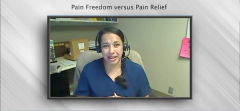
The Importance of Patient Communication
Episodes in this series

A key opinion leader discusses the importance of patient communication when optimizing the efficacy of acute migraine treatment.
Amaal J. Starling, MD: Our patients with migraine have come to us with a history of stigma: a history of family members, the lay public, their workplace, and even their medical and health care providers not listening to them and not communicating with them, which is why it’s so important that once they come to us as their neurologists and their headache treatment providers, that we emphasize how dedicated we are to communicating with them. Communication is key from the first appointment that we have with them and then through the follow-up and the subsequent communication that we have with them through that entire patient-doctor relationship.
A part of that treatment plan is making sure you describe to the patient what that plan is—for preventive treatment, acute migraine attack, and headache rescue treatment. What happens when my acute migraine attack plan is not going to work, what do I do? What does your patient do? Do they call you? Do they have medications they can take? Do they go to the emergency department? If they go to the emergency department, what do they do, what do they ask for, who do the emergency department doctors call?
You want to make sure that they have a plan as to what to do because it’s a really scary place to be in for that patient, and often they’re not in a position where they can appropriately advocate for themselves. Then what is the follow-up plan? When should they call you back with their results of how they’re doing with the medications that they’ve been prescribed, or when should they come back to see you in follow-up? When they come back to see you, what is the information you want to know? When you’re talking about acute migraine therapies, what is the appropriate information to know? You want to know not only if it is effective but what do they mean by it’s effective. Does it mean that it’s stopping the attack completely? Are they able to get back to what they need to get back to immediately? Are they able to get back to work, school, taking care of their kids, their pets, etc? Are they having any adverse effects from the medication? Do they have to take a second dose? Do they have to sleep it off because they’re having those adverse effects? Are they having to take something for nausea because the medication is making them nauseous or because the medication is not addressing the nausea that’s related to the migraine attack? You want to dig into all those different factors to see if you can optimize their treatment plan. You want to also find out how often they’re having to take that medication.
A great way to be able to streamline that communication is to ask the patient to keep a headache diary. I know a lot of patients find this is very frustrating, but 1 of the reasons that a patient finds that this is frustrating is because a doctor doesn’t ask to take a look at it. They feel like it’s frustrating to keep a headache diary if no one is going to take a look at it. If you ask for it and if you look at it, they’re more motivated in keeping it. They can keep it on their phone. They can use any type of app. A lot of my patients like using the app Migraine Buddy, or they can use an old school calendar where you can just flip through it. I usually have patients tick the days where they’re taking a medication or tick the days where they’re debilitated by a migraine attack and they took medication.
Then you can take a look at the calendar and see how many days that is. How that’s helpful from an acute migraine treatment perspective is you can see clusters, or you can see it spread out throughout the month. If you see that and if someone is communicating with you, whether it be through the diary or verbally, that they’re having to use an acute migraine treatment 5 days in a row versus a patient who is taking acute migraine treatment options scattered 5 days randomly throughout a month, it tells me different information. Five days in a row tells me there may be 1 migraine attack that has not been broken, while the 5 random days means there are 5 separate migraine attacks. There’s an increased migraine frequency versus a bad migraine attack that they haven’t been able to break.
I have a different treatment approach for those 2 patients. One patient, I’m going to focus on acute treatment. I’m going to try to optimize my acute treatment options for that patient. I’m going to say, “OK, maybe I need to use something more potent, or maybe that patient is not using their acute treatment options early enough.” This is an issue that I have with a lot of my patients.
Many of our patients, they start getting head pain and they start feeling a little light sensitivity and they think, “Oh, maybe this is just a headache, maybe this isn’t a migraine. I’m just going to wait and see what happens.” And then they start getting nauseous, and they’re like, “Oh, I think it’s a migraine,” and their head is really hurting. Now they’re in their actual moderate to severe pain phase of the migraine attack, and we know that a lot of our acute therapies aren’t as effective when we’re using them in the later stages or the moderate to severe pain stages of a migraine attack. We want to encourage patients to use their as-needed acute therapies for migraine in the early stages of an attack.
I’ll mention to the patient, “I want you to use your acute migraine medication earlier in the attack. I want you to combine it with an NSAID [nonsteroidal anti-inflammatory drug]. I’m going to prescribe a more potent medication.” Maybe I’ll recommend an injection therapy for them. We’re going to combine it with the NSAID, we’re going to combine it with the neuroleptic medication, we’re going to be more aggressive with it. Then if we can stop that migraine attack, maybe it won’t be 5 consecutive days, maybe it will only be 1 to 2 days. Then with the other patient who has 5 random attacks, I’m probably going to focus on more preventive measures. That’s why it’s so important to increase the communication as well as keep a headache diary, which is a part of communication.
Newsletter
Keep your finger on the pulse of neurology—subscribe to NeurologyLive for expert interviews, new data, and breakthrough treatment updates.












































